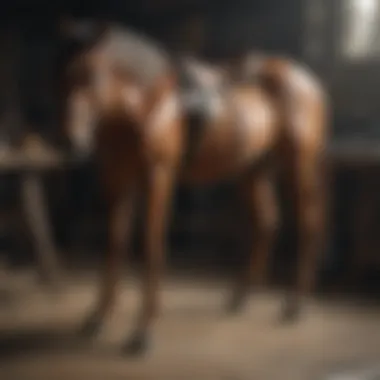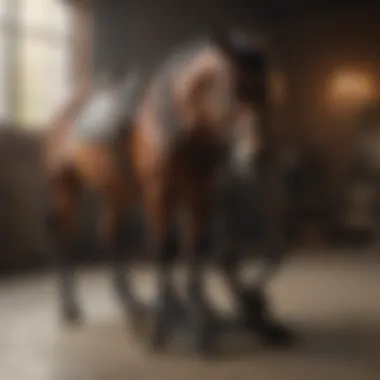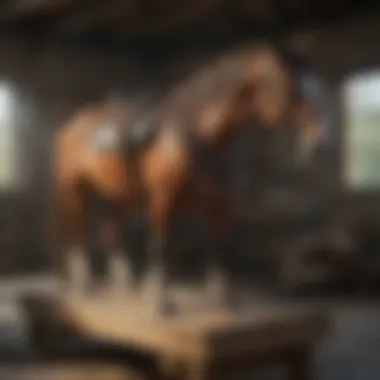Exploring the Versatility of Stanley Saw Horses


Intro
Stanley saw horses have been a staple in the home improvement industry for decades, embodying a blend of functionality and simple design. These tools, while often overlooked, play a significant role in supporting various applications—from woodworking projects to general construction tasks. Their strong structural integrity and versatile usage make them essential for professionals and home improvement enthusiasts alike.
When planning a DIY project, having reliable support is crucial. That’s where the merits of Stanley saw horses come into play. They not only provide a stable base for cutting, sanding, or assembling materials, but they also help in maximizing efficiency and safety. Understanding the rich history and functionality of these tools allows users to appreciate their impact on the craft.
Moreover, the relevance of saw horses in today's home environments can't be overstated. In a time when home improvement projects are soaring, these humble supports allow individuals—particularly homeowners and those managing household renovations—to tackle DIY tasks with confidence. Their simplicity does not detract from their value; instead, it makes them more accessible to those who may not possess advanced woodworking skills.
In this piece, we’ll take a closer look at the landscape of Stanley saw horses, addressing not only their origins and design principles but also the many innovative ways they can be utilized. By doing so, we hope to illuminate not just their historical significance but also their practicality in contemporary home improvement tasks.
Understanding Stanley Saw Horses
When diving into the world of carpentry and construction, understanding the tools at your disposal is half the battle won. Stanley saw horses are often an unsung hero in this domain, playing a vital role in simplifying tasks for both seasoned carpenters and enthusiastic homeowners alike.
Definition and Purpose
Stanley saw horses can be defined as sturdy supports designed to hold materials during cutting, assembly, and other manual tasks. Typically made from high-quality wood or durable plastic, their design allows for a level and secure platform for various projects.
The purpose of these saw horses goes beyond mere support. They offer versatility in project organization, allowing users to approach tasks methodically. For instance, when cutting lumber, placing the wood atop a saw horse keeps it at a comfortable height, promoting safety and efficiency. Additionally, by providing a stable surface, they minimize errors that could lead to wasted materials.
As you may often hear in conversations about tools, a saw horse isn't just a piece of equipment; it's an essential part of the process—in many ways, it’s the backbone of carpentry work.
Historical Context
The origins of the saw horse can be traced back centuries, with early versions crafted from simple materials—logs or planks held at an angle. In ancient crafting cultures, these basic support structures were indispensable.
Fast forward to the 19th century, as industrialization took root, manufacturers like Stanley began refining the design. They introduced models with more robust features, adjustable heights, and lightweight frames, making the saw horse more accessible to both professionals and hobbyists alike. This evolution reflects a growing understanding of ergonomics and user experience: tools were to be not just functional but comfortable and efficient.
Even today, Stanley remains at the forefront of saw horse design. Each model showcases improvements based on user feedback, adapting to the ever-changing landscape of home improvement and construction. The historical journey of this tool underscores its enduring importance and the continual innovation that accompanies it.
Models of Stanley Saw Horses
Understanding the models of Stanley saw horses is essential for anyone looking to optimize their woodworking or construction projects. These models are designed with specific functions in mind, catering to different needs and preferences. Each model brings its own set of benefits, whether it be in terms of stability, portability, or additional features. Identifying the right type can greatly enhance the efficiency of your tasks, making the effort of selecting the appropriate saw horse very worthwhile.
Classic Models
Stanley has a rich history of creating classic saw horse models, which have stood the test of time. These traditional designs, such as the Stanley 67 saw horse, prioritize stability and simplicity. They’re often crafted from sturdy materials like wood or steel, ensuring they can support a significant amount of weight without wobbling. For many, these classic models evoke a sense of nostalgia, harking back to a time when craftsmanship was the order of the day.
The durability of these models carries its own advantages in projects that require long-term solutions. Households can rely on them for everything from basic repairs to significant renovations without worrying about frequent replacements. Their straightforward design means they are also simple to set up and use, making them a favorite for first-timers who are just getting their feet wet in DIY projects.
Innovative Designs
In contrast to the classic saw horses, Stanley has been quick to adapt to modern demands, introducing innovative designs that incorporate advanced materials and unique features. Models like the Stanley 36, for instance, come with adjustable heights and folding mechanisms that enhance their versatility. These innovations cater not just to professionals but also to homeowners who might require more flexibility in their workspace.
One significant benefit of these innovative designs is their portability. Many of the new models are lightweight and fold up compactly, making them easier to store when not in use. This characteristic is particularly appealing to housewives and homeowners who may have limited space in their garages or sheds. Enhanced features, such as integrated clamps, allow users to secure materials easily, turning these simple tools into multifunctional assets.
Comparative Analysis
When comparing the classic and innovative models of Stanley saw horses, several factors come into play. Durability is a key consideration; classic models often win in this category due to their robust construction. However, innovative designs shine when it comes to versatility and user-friendliness.
It’s also worth mentioning price points; classic models can sometimes be less expensive, appealing to homeowners working on a budget. Meanwhile, innovative designs may carry a premium but usually come with features that justify the investment. Before selecting a model, consider what you prioritize: simplicity, ease of use, or extra features.
In summary, whether one opts for a classic or innovative Stanley saw horse depends largely on the specific needs, preferences, and the types of projects being considered. Understanding these differences enables users to make informed decisions that can enhance their overall experience in woodworking and home improvement.
Materials and Construction


Understanding the materials and construction methods used in Stanley saw horses is crucial for several reasons. First, the choice of materials directly influences the durability and stability of the saw horses. For housewives and homeowners, this means investing in tools that will not only perform well but also stand the test of time, offering good value for money. Additionally, the construction techniques play a significant role in how these tools perform in various settings, whether it’s for carpentry projects or general home improvement tasks.
Types of Materials
When considering the materials used in Stanley saw horses, several options come to mind, each with its own set of benefits and drawbacks. Here’s a closer look:
- Wood: Traditionally, saw horses were made from solid wood. This gives them a classic look and provides substantial weight for stability. However, wood can be susceptible to warping or rotting if not properly treated.
- Metal: Many modern saw horses are built from steel or aluminum. Metal structures tend to be much more durable than wood, resisting changes due to weather conditions. Moreover, they are often lightweight, making transportation easier for the user.
- Plastic: Some saw horses are constructed from high-density plastic. These can be surprisingly robust and are usually resistant to chemicals and moisture. They are perfect for those looking for lightweight options without compromising on strength.
- Composite Materials: An innovative trend includes using composite materials that blend plastics and fiberglass. These materials can be highly effective, allowing for lightweight designs that also maintain high load capacities.
The choice of material is critical. A saw horse made from wood may provide a rustic charm but might not withstand heavy use if it’s not properly maintained. Metal alternatives can endure tough jobs, but one must be cautious of welding quality and rust. Ultimately, the best material will depend on the user's specific needs, including the projects at hand and their operating environment.
Manufacturing Techniques
The methods employed to manufacture Stanley saw horses reveal a lot about their quality. Good craftsmanship reflects not just in appearance, but in durability and functionality as well. Here’s a breakdown of some common techniques used:
- Injection Molding: Often used for plastic saw horses, this technique ensures a consistent and durable product. The material is heated until it becomes liquid and then injected into molds. This allows for complex shapes and details in production.
- Welding: For metal saw horses, welding is essential. Proper welding techniques enhance the strength of joints, preventing failure under load. It’s important to inspect welds as poor welding can lead to weakness.
- Crafting Joints: For wooden saw horses, the type of joints used in construction affects stability. Mortise and tenon joints or dowel joints add strength far beyond simple butt joints, which tend to weaken over time.
- Surface Treatments: Finally, finishing methods such as powder coating for metals or sealing for wood are critical. These treatments protect against wear and tear and enhance the saw horse's overall aesthetic.
In summary, the materials used in Stanley saw horses, as well as the techniques employed in their production, play pivotal roles in their overall effectiveness and durability. Homeowners and DIY enthusiasts should consider these factors carefully, as they directly impact the usability and lifespan of their investment.
"A well-constructed saw horse can be the difference between a successful project and a frustrating one."
By keeping these aspects in mind, one can make a more informed decision about choosing the right Stanley saw horse for their needs.
Applications of Stanley Saw Horses
Stanley saw horses are not just simple constructions made of wood or metal; they are pivotal tools in many areas, merging form and function beautifully. Understanding their various applications helps illuminate their value not only in carpentry but also in everyday tasks around the home. Each of the environments where these saw horses are utilized—woodworking, construction, and DIY projects—offers unique benefits, streamlining processes and improving efficiency.
In Woodworking
Woodworking is an art that requires precision and stability, and this is where Stanley saw horses shine. Their sturdy and adjustable nature allows craftsmen to create a solid foundation for handling wood pieces of various sizes. Whether you are cutting, sanding, or assembling, these saw horses provide a level surface, making the job much easier.
For instance, a woodworker needs to cut long planks of timber. By placing them securely on Stanley saw horses, they ensure that the wood doesn’t wobble, preventing accidents that can lead to injuries or miscuts. A simple trick is to position the saw horses at the correct height to match your cutting tool, which allows for a comfortable working posture, reducing fatigue over longer sessions.
"Having a reliable pair of saw horses can elevate a novice woodworking project into something professional."
In Construction
In the bustling world of construction, time is money. Stanley saw horses play a vital role, aiding both in efficiency and safety. These tools can serve multiple functions, from holding materials during onsite assembly to acting as temporary tables for quick repairs. Fewer tools mean more space and faster workflow, which enhances overall productivity.
Consider a situation where a team is setting up a framing for a new house. The ability to quickly set up saw horses to hold framing studs while they are being assembled can cut down on labor time significantly. With such aids, workers can focus on their tasks without the constant need to secure every piece individually. Moreover, having saw horses positioned strategically around a site can help in maintaining a clean and organized workspace, essential for safety.
In DIY Projects
For the aspiring DIY enthusiast, Stanley saw horses are indispensable. They foster creativity by providing the support needed to transform an idea into reality. From crafting furniture to minor repairs, saw horses make every project more manageable.
When planning a home repair, like installing shelves or replacing a door frame, saw horses serve as a supportive base for tools and materials. They can hold everything from paint buckets to lumber, keeping the workspace clutter-free and efficient. Not only do these saw horses support our physical endeavors, but they also inspire us to tackle tasks that could otherwise seem daunting.
As a pro tip, using these saw horses in combination with clamp systems can open a whole new realm of possibilities for various DIY projects. This combination enhances versatility, ensuring that projects are not only completed with precision but also with safety in mind.
Coherently, the applications of Stanley saw horses extend far beyond their traditional uses, anchoring them as an essential tool in any home or workshop. Whether in woodworking, construction, or everyday DIY endeavors, they exemplify how practical solutions can lead to improved outcomes.
Best Practices for Use
In any craft or endeavor, understanding the best practices can be the linchpin for success. When it comes to using Stanley saw horses, there are several elements that can enhance both functionality and safety. Proper setup not only ensures that your projects are executed efficiently but also prevents accidents that may arise from improper usage. This section dives into these crucial aspects, aiming to empower housewives and homeowners with the knowledge they need to make the most of their saw horses.
Setting Up
A well-set-up saw horse provides a sturdy foundation for various tasks, whether you're cutting lumber or assembling a DIY project. Here are key considerations:


- Level Surface: Always position your saw horses on a flat surface. Uneven ground can lead to instability, increasing the risk of accidents.
- Correct Distance: Ensure the saw horses are spaced to accommodate the length of the material you’re working with. For long boards, spacing them too close can cause sagging in the middle.
- Secure the Load: If you’re using clamps or straps, make sure they are tight. A loose load can shift unexpectedly, posing a safety hazard.
- Test Stability: Before commencing your work, gently shake the setup to verify it is secure. A wobbly arrangement can ruin your project and lead to injuries.
In every situation, keeping these steps in mind fosters a productive environment where you can focus on your work rather than worrying about mishaps.
Safety Considerations
Using saw horses stands more than just about utility; it's also about safety. Here are some pointers to keep those potential accidents at bay:
- Protective Gear: Always wear appropriate gear. Safety glasses and gloves are imperative, especially when working with sharp tools.
- Weight Limit Awareness: Check and adhere to the weight limit of your saw horses. Overloading them can cause structural failure.
- Clear Work Area: Keep your surroundings uncluttered. Having ample space to maneuver around your saw horses reduces trip hazards.
- Child Safety: If kids are around, ensure that they are at a safe distance from your workspace. Accidental bumps can happen faster than you think.
"In woodworking, as in life, the simplest precautions can make a world of difference."
By integrating these practices into your routine, you not only protect yourself but also enhance your efficiency as you engage with your projects. Remember, every little detail matters in achieving stellar results!
Maintenance of Stanley Saw Horses
Maintaining Stanley saw horses is crucial to ensure their long-lasting performance and safety. Regular upkeep not only enhances the lifespan of these tools but also ensures they remain effective in their primary purpose of providing stability during various projects. A well-maintained saw horse lowers the risk of accidents and can prevent potential damage to materials being worked on. By investing a bit of time in care and maintenance, enthusiasts and professionals alike can keep their Stanley saw horses in tip-top shape, ready for any project that comes their way.
Routine Care
Taking care of your Stanley saw horses doesn't have to be a daunting task. Establishing a routine can help keep them functional and prolong their life. Here are some practical steps to follow:
- Regular Inspection: Every so often, check for signs of wear or damage. Look for cracks, bends, or rust, especially if they are stored outdoors.
- Cleaning: After each use, give them a wipe down. Wood surfaces might harbor sawdust or glue. A simple damp cloth can do wonders. For metal parts, a soft brush or cloth can help remove any residue.
- Protective Coating: Consider applying a protective oil or sealant on wooden surfaces periodically. This helps to ward off moisture and keeps the wood looking fresh.
- Storage: Store your saw horses in a dry place to prevent rust on metal parts and warping or splitting in wood. If space allows, keep them off the ground or on a shelf.
Remember, a little bit of care goes a long way. As they say, "An ounce of prevention is worth a pound of cure."
Troubleshooting Common Issues
Despite best efforts, common issues can arise with your Stanley saw horses. Knowing how to troubleshoot these problems can save the day:
- Wobbly Structure: If your saw horse feels unstable, check the legs. Sometimes, one can be shorter due to uneven ground. Adjusting the leg or placing shims can rectify this.
- Rust Formation: If you see rust on metal parts, do not panic. You can usually remove it with some fine steel wool and a rust remover. After cleaning, always apply a coat of oil to prevent further rusting.
- Difficulty Folding/Unfolding: If the hinges are stiff or stuck, it might just need some lubricant. A spray lubricant such as WD-40 can free things up beautifully. Just make sure to clean off any excess product afterward.
- Weak Joints: If joints are getting loose, using a wood glue or tightening any screws can help restore their strength.
Regular maintenance can save you from headaches down the line. A little time spent today means more productive work tomorrow.
With these tips in your toolkit, you're well on your way to maintaining your Stanley saw horses for years to come. Taking care of your tools reflects not only on the tools themselves but also on the quality of the work you produce. Remember, every detail matters.
Versatile Uses Beyond Woodworking
Stanley saw horses are often lumped into the woodworking toolbox, but their capabilities stretch far beyond that realm. This article aims to paint a picture of the myriad ways these tools can serve homeowners and hobbyists alike. From photography setups to event organization, these seemingly simple structures offer more than just support; they provide a platform for creativity and efficiency.
In Photography
When it comes to photography, creativity knows no boundaries. Stanley saw horses can neatly step in as makeshift tables or background supports during shoots. Their height and stability offer a solid foundation for various equipment like tripod mounts and lighting setups.
Consider a scenario where a photographer is tasked with capturing a vibrant outdoor event. Rather than being weighed down by bulky, traditional tables, the photographer can easily position saw horses to create elevated platforms for gear.
- Flexible Setup: These saw horses allow for easy adjustments. Their lightweight yet sturdy frame makes them portable, giving photographers the freedom to find that perfect angle without the hassle of lugging around heavier equipment.
- Cost-Effectiveness: Investing in saw horses can save money. They serve multiple purposes, double as props on set, and eliminate the need for expensive studio-grade furniture, thus streamlining budgeting for any project.
"Stanley Saw Horses transform an ordinary shoot into an extraordinary setup by enabling strong and creative positions for cameras and lighting."
In Event Setup
Think beyond the workshop; Stanley saw horses shine when it comes to organizing events. Their versatility isn’t just about supporting wood; it’s about improving workflows in both indoor and outdoor gatherings. Picture a community function or a family reunion.
- Table Arrangements: Saw horses can swiftly be turned into table bases, enabling quick assembly of food tables, registration desks, or craft stations. Just add a plywood sheet or a sturdy tabletop, and voilà! You have a table ready for use.
- Space Optimization: In smaller venues, traditional tables may take up considerable space and restrict movement. Saw horses, when paired with lightweight materials like plywood, can create temporary yet effective surfaces that can be set away after the event.
- Creative Displays: Stand-alone saw horses can be decorated or used as display stands for items like wedding cakes, gifts, or auction pieces. This adaptation is particularly appealing for individuals who seek a unique visual element in their events.
Utilizing Stanley saw horses for tasks other than woodworking demonstrates their range and adaptability, reflecting an intelligent approach to tool usage. Whether it’s for snapping that perfect shot or organizing a memorable gathering, these sturdy structures empower users to elevate their projects, all while staying practical in both design and application.


Comparative Overview of Competitors
In today's market, it’s crucial for consumers to understand their options when it comes to selecting tools like saw horses. Saw horses have become a staple for both professionals and DIY enthusiasts alike. The importance of a comparative overview cannot be overstated; it helps buyers make informed decisions by examining the strengths and weaknesses of leading brands, as well as the performance they promise. In this context, we will look into notable brands and what distinguishes them from one another, along with the performance metrics that can guide a purchase.
Leading Brands
When taking a deep dive into the world of saw horses, several names come to the forefront. Some of the leading brands that deserve attention include:
- Stanley: Known for their durable and reliable designs. Their saw horses offer great stability and ease of setup, catering to both amateurs and professionals.
- DeWalt: They provide innovative features with modern designs including foldable models that are portable yet sturdy. Ideal for those on the go.
- Bosch: This brand excels in engineering and precision. They create saw horses with advanced features that enhance functionality in complex tasks.
- Kreg: Primarily focused on woodworking, Kreg’s saw horses are known for their versatility and ability to serve multiple purposes.
When choosing a saw horse, it is not just about the brand name. Consumers should consider the specific needs they have. A carpentry novice might opt for a simpler model, while seasoned professionals may seek advanced features and greater weight capacity.
Performance Metrics
To better grasp how these brands stack up against one another, it’s essential to look at performance metrics. Performance can vary widely based on various factors:
- Load Capacity: This refers to how much weight the saw horse can handle safely. For instance, Stanley saw horses typically support up to 1,000 pounds, which is impressive compared to other competitors.
- Ease of Use: How quickly can a user set up or dismantle the saw horse? Some models are foldable and lightweight, making them preferable for quick setups.
- Durability: Materials play a pivotal role. Metal and high-quality plastic can endure more wear and tear than lower-grade options.
- Stability: A saw horse must stand firm on various surfaces. Some brands implement wider bases or rubber feet to enhance stability.
- Versatility: Some saw horses are designed for specific tasks, while others can serve multiple functions. This adaptability can greatly influence user preference.
"Choosing the right saw horse is about more than just price or aesthetics; it's about understanding your own needs and how the tool fits into your broader projects."
By rigorously evaluating these parameters, potential buyers can navigate the crowded market of saw horses more effectively, ensuring they make a selection that aligns with their specific needs and expectations.
Future of Saw Horses
The realm of saw horses is evolving, and understanding the future of these essential tools is crucial for anyone involved in woodworking or construction. The landscape is shifting thanks to emerging technologies and a growing emphasis on sustainability. Recognizing these elements can help both amateur and seasoned users adapt to changes in the market and enhance their workflows.
Emerging Technologies
Saw horses are no longer just simple wooden frames; they are entering the digital age. Advanced materials and innovations are making these tools more versatile and efficient. For instance, the integration of smart technology has started to gain traction. Imagine a saw horse equipped with sensors that can detect weight distribution and alert users if the load is unbalanced. This could significantly improve safety on the job site.
Another promising technological advancement is the use of adjustable and modular designs that allow users to customize the height and stability of the saw horse based on their specific project needs. Such flexibility can lead to increased comfort and decreased physical strain over lengthy periods of work.
Furthermore, tools that connect to apps via Bluetooth are also on the horizon. This could open avenues for better project planning and real-time adjustments, proving especially beneficial during large-scale construction tasks.
"The innovative saw horse of the future merges safety with smart tech, revolutionizing woodworking and construction methods."
Sustainable Materials
As environmental awareness continues to grow, the shift towards sustainable materials is becoming a focus in the manufacture of saw horses. Traditional wood may still reign supreme, but alternatives are surfacing that prioritize both quality and eco-friendliness.
Biocomposite materials, which combine plant-based fibers with polymers, are emerging as robust contenders. These materials not only reduce dependence on hardwood forests but also offer a lower carbon footprint during their production phase.
Another avenue worth exploring is the recycling of plastics into durable saw horses. This approach is beneficial for the environment and can often lead to costs savd in manufacturing. By opting for recycled materials, manufacturers can deliver lightweight and sturdy solutions while making a positive impact by reducing waste.
In summary, the future of saw horses is bright and full of possibilities, from smart technologies that enhance functionality to sustainable materials that reflect our growing responsibility to the planet. By staying informed about these advancements, users can make educated choices that align not only with their projects but also with broader environmental objectives.
Finale
As we reach the finish line of our exploration of Stanley saw horses, it's crucial to reflect on the importance of this topic. The versatility and functionality of these tools are not just limited to carpentry; they span a wide array of activities, making them essential in various settings.
Summary of Key Points
- Historical Significance: Understanding the roots of Stanley saw horses gives us appreciation for the ingenuity behind them. Their development reflects the evolution of woodworking and construction techniques.
- Model Variety: The different models offered by Stanley cater to diverse needs, from the novice DIYer to seasoned professionals. This range allows users to select a saw horse that matches their specific requirements perfectly.
- Maintenance Matters: Proper maintenance is vital for longevity. Regular checks and a few simple care steps can keep saw horses in top shape, ensuring they’re always ready when needed.
- Widely Applicable: Beyond traditional woodworking and construction, these saw horses find use in photography, event setups, and more, proving their adaptability.
Final Thoughts
To wrap things up, the world of Stanley saw horses is more than just a collection of tools; it's a gateway to achieving better craftsmanship and efficiency in various projects. Whether you're a housewife embarking on a new home project or a house owner looking to enhance your skills, recognizing the value that these saw horses bring to your endeavors is paramount.
With the right approach and understanding, the use of Stanley saw horses can significantly elevate the quality of your work. Plus, engaging with these essential tools fosters a sense of achievement and satisfaction that is hard to match. As you look toward your next woodworking or DIY project, remember the key points discussed. The right tools, coupled with a willingness to learn, can lead to impressive transformations in your space.
"Tools don't just help us create; they inspire us to innovate."
So, pick your Stanley saw horse, roll up your sleeves, and let your next adventure begin!







